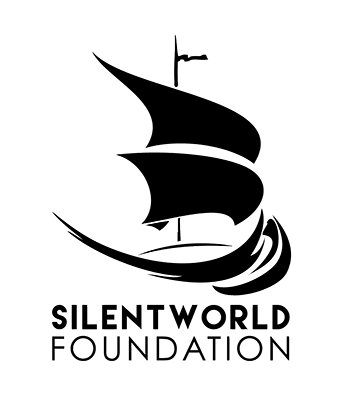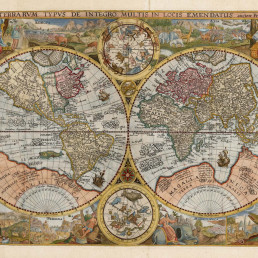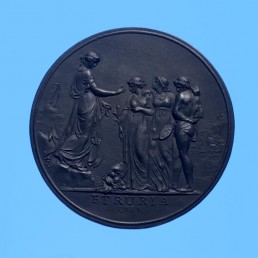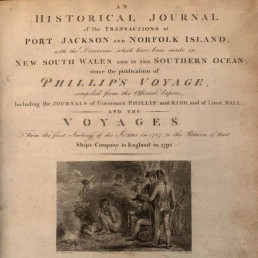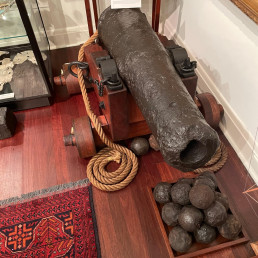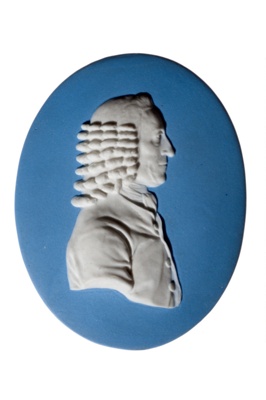
Name/TitlePortrait medallion of Dr John Fothergill
About this objectA charming likeness of Dr John Fothergill, the prominent physician, botanist, and patron of Sydney Parkinson. Fothergill, a practicing Quaker, was not only a reputable physician, but had a lifelong interest in botany and conchology. As a result, he became an intimate friend of Sir Joseph Banks, and corresponded widely with the great naturalist. It was Fothergill who bought the shell collection of Parkinson, and he was also instrumental in seeing Parkinson's unofficial account of Cook's first voyage through the press, defending the literary property against lawsuits and preparing a second edition during the long wait for resolution of the dispute.
This portrait, by long tradition, has been attributed to Wedgwood's great craftsman John Flaxman, but as with many of these medallions this has never been absolutely confirmed. Reilly and Savage comment that the source for the design has been considered to be an engraving by Valentine Green dated 1781, but that the medallion's inclusion in the 1779 Wedgwood catalogue makes this unlikely. As Reily and Savage confirm, the likely source is the Medical Society medal of 1773, designed by the famous Lewis Pingo, well known for his designs on various naval medals, including the Royal Society medal in commemoration of Captain Cook.
MakerJosiah Wedgwood - Maker
Maker RoleMaker
MakerLewis Pingo - Artist
Maker RoleArtist
Date Madec1779
Period18th century
Place MadeStaffordshire, United Kingdom
Medium and MaterialsPorcelain (jasperware).
Measurements10.9cm x 8.5cm
Object TypeCeramics and Pottery
Object numberSF000691
Copyright Licence![]() Attribution - Non-commercial - No Derivatives (cc)
Attribution - Non-commercial - No Derivatives (cc)
Explore by category
Maps and Charts
Date range: 1541-1836
Ship Models
Date range: 1629-1890
Maritime Paintings
Date range: 1793-1849
Manuscripts and Ephemera
Date range: 1768-c1850
Medallions & Convict Tokens
Date range: 1619-1880
Landscapes
Date range: 1768-c1850
Books
Date range: 1694-c1850
Currency and Shares
Date range: 1624-1823
Printed Material
Date range: 1541-1836
Maritime Archaeology
Date range: 1629-1854
Curator's corner
New acquisitions, staff favourites and curios
The mug is decorated with an underglaze and a blue transfer print. On the body, it is titled ‘Emigrants to Australia’. This type of body and glaze was discontinued by 1840. Comparison of the handle shape and the profile of the foot, point to the attribution of manufacture by the Davenport Factory.
Delta was a ship-rigged vessel with two decks and three masts. It was built in Dordrecht, Netherlands in 1839 at the shipyard of Jan Schouten and registered in the same port. Its hull was constructed of oak and sheathed in ‘yellow metal’. Delta was owned by H. van der Sande at the time of its loss and was engaged as a cargo trader.
The Delta carried 29 crew and passengers, while sailing from Melbourne to Batavia in ballast when wrecked at Kenn Reefs on 30 May 1854 whilst under the command of Captain J.G. Kunst. This vessel loss supports the pattern of shipwrecks located on a well-travelled shipping route that was poorly charted until the mid-nineteenth century. The crew of the Delta could see four other shipwrecks at Kenn Reefs at the time of their vessel’s loss.
Important image of a ship associated with Matthew Flinders, that would shortly become one of the most famous early shipwrecks in eastern Australian waters. This is a fine ship’s portrait, by one of the great exponents of the art
